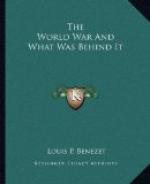Prussia, which had been cut down to about half its former size by Napoleon, got back some of its Polish territory, and was given a great deal of land in western Germany along the River Rhine. Part of the kingdom of Saxony was forcibly annexed to Prussia also. It is needless to say that its inhabitants were bitterly unhappy over this arrangement. Austria kept part of her Polish territory, and gave the rest of it to Russia.
The southern part of the Netherlands, which is today called Belgium, had belonged to the Hapsburg family, the emperors of Austria. As was previously said, it was conquered by the French and remained part of France until the fall of Napoleon. It was now joined with Holland to make the kingdom of the Netherlands. Its people were Walloons and Flemish, almost entirely Catholic in their religion, and they very much disliked to be joined with the Protestant Dutch of Holland.
[Map: Europe in 1815]
The state of Finland, which had not been strong enough to defend itself against its two powerful neighbors, Sweden and Russia, had been fought over by these two powers for more than a century. It was finally transferred to Russia, and in order to appease Sweden, Norway, which had been ruled by the Danes, was torn away from Denmark and made part of the kingdom of Sweden. The Norwegians desired to remain an independent country, and they loved the Swedes even less than they loved the Danes. Therefore, this union was another source of trouble. The greater part of the kingdom of Poland and all of Lithuania were joined to Russia.
Russia got back all of the territory she had taken in 1795, and in addition large parts of the former shares of Prussia and Austria. In order to pay back Austria for the loss of part of Poland, she was given all of northern Italy except the counties of Piedmont and Savoy near France.
The German states (and these included both Austria and Prussia) were formed into a loose alliance called the German Confederation. England’s share of the plunder consisted largely of distant colonies, such as South Africa, Ceylon, Trinidad, etc. France shrank back to the boundaries which she had had at the beginning of the revolution. The kings of France, of the Two Sicilies, and of Spain (all of them members of the Bourbon family) who had been driven out by Napoleon, were set back upon their thrones.
This arrangement left Italy all split up into nine or ten different parts, although its people desired to be one nation. It left Austria a government over twelve different nationalities, each one of which was dissatisfied. It joined Belgium to Holland in a combination displeasing to both. It gave Norway and Finland as subject states to Sweden and Russia respectively. It left the Albanians, Serbians, Roumanians, Bulgarians, and Greeks all subject to the hated Turks. It set upon three thrones, once vacant, kings who were hated by their subjects. It divided the Poles up among four different governments—for,




